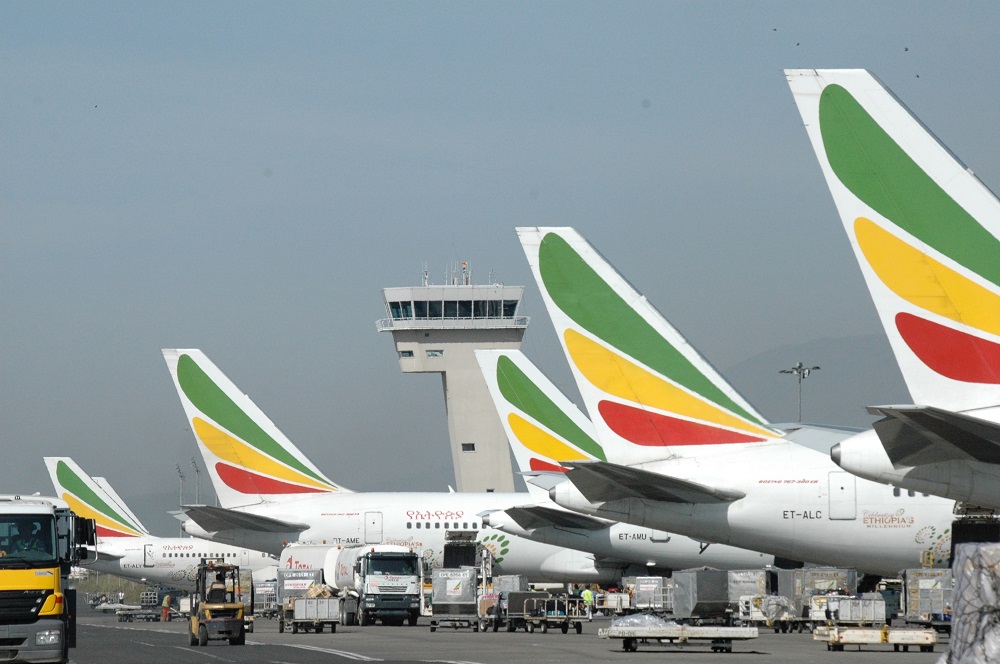The flight data and cockpit voice recorders have both been recovered from the crash site of Ethiopian Airlines Flight ET302 as the number of airlines grounding Boeing’s latest version of its workhorse 737 has increased to more than 20.
The deadly crash on Sunday of the Ethiopian plane with 157 people on board was the second involving a new Boeing 737 MAX 8 since October.
The “black boxes” will be crucial in determining what happened to the Ethiopian aircraft and if there is a link to a Lion Air 737 MAX 8 crash shortly after take-off from Jakarta last October.
In what is proving to be a widening crisis for Boeing that saw its share price close down by more than 5 percent Monday, aviation authorities in China and Indonesia ordered that Boeing 737 MAX aircraft be grounded.
Ethiopian Airlines also ordered its remaining 737 MAX fleet out of the air as a precautionary measure.
Blue chip carrier Singapore Airlines has also temporarily withdrawn six Boeing 737 Max 8’s from service, saying the safety of its customers and crew were its highest priority. The Civil Aviation Authority of Singapore also suspended the operation of MAX aircraft into and out of the city-state.
Other operators to ground the planes include Aeromexico, Royal Air Maroc and Cayman Airways.
But the US Federal Aviation Administration, noting that the investigation has just begun, says it does not have information to draw conclusions or take any action.
The FAA continually assesses and oversees the safety performance of US commercial aircraft and said it would take “immediate and appropriate action” if it identified a safety issue.
It outlined in a Continued Airworthiness Notification to the International Community how it had been monitoring design changes being made to the 737 MAX in the wake of the Lion Air crash.
Boeing has been developing these over the past several months and says they are designed to make the 737 MAX “even safer”.
“Safety is a core value for everyone at Boeing and the safety of our airplanes, our customers’ passengers and their crews is always our top priority,” the company said.
“The 737 MAX is a safe airplane that was designed, built and supported by our skilled employees who approach their work with the utmost integrity.”
US carriers, which operate 74 of the global fleet of 387 737 MAX aircraft, are continuing to fly the planes but Transportation Secretary Elaine Cho also told reporters that the FAA would “take immediate and appropriate action” if it identified an issue which affected safety.
Other airlines such as Norwegian, LOT Polish Airlines flydubai, Smartwings, S7 Group and Oman Air are also continuing to fly pending further information.
What is known about the Ethiopian crash so far is the pilots reported technical difficulties and asked to return to Addis Ababa during a flight to Nairobi.
READ: Pilot of Fatal Ethiopian flight reported “technical difficulties”.
The plane took off from runway 27R at Bole Airport at 8:38 am local time and contact was lost six minutes later at 8:44 am.
Weather at the time was fine with a visibility of more than 10kms, with a few clouds at 2500ft, according to the Aviation Safety Network.
The Aviation Herald said the last transponder data received from the plane indicated it was flying at just over 9000ft above sea level when contact was lost. Addis Ababa airport is just over 7600ft above sea level.
It noted that photographs of the crash site indicated the plane had been in a deep dive.

Flightradar 24 data shows the 737 MAX 8 was climbing normally with constant speed and altitude lines when suddenly all radar and systems contact is lost. However, it points out that its ADSB coverage is limited in the area.
There is so far no hard evidence that the Ethiopian and Lion Air crashes are linked but the latest tragedy has sparked intense debate about the Boeing 737 MAX 8 and the fact that a two of the new planes have crashed in less than six months.
Questions have also been raised about the disparity in experience between the co-pilot and captain on the Ethiopian aircraft.
The captain had 8000 total flying times, although it is not clear how much of that was on 737s, while the first officer had just 200 hours.
Boeing and the US National Transportation Safety Board have both sent teams to the crash site to work with Ethiopian authorities to try and determine a probable cause.
A preliminary report in the October 28 Lion Air crash pointed to a sequence of events that started with aircraft maintenance and ended with the pilots failing to follow a procedure that could have saved the plane.
READ: Indonesians retrieve data from second Lion Air black box.
A faulty angle of attack sensor caused automated systems on the plane to push down the nose and the flight crew was still fighting this when the plane plunged into the sea with 189 people on board. The sensor measures the pitch of the aircraft and whether the nose is too high.
The crash sparked a debate about a new feature on the plane, the Maneuvering Characteristics Augmentation System (MCAS). MCAS is not engaged when the flaps are extended so some pilots believe it is unlikely to have been a factor in the Ethiopian crash.
This is software known as a flight control law that was added to the MAX to compensate for design changes and help pilots cope with a stall by improving aircraft handling characteristics and decreasing the pitch-up tendency at elevated angles of attack.
It essentially helps push down the nose if the aircraft’s computers detect a high angle of attack but there has been controversy among US pilots about whether Boeing flagged the feature sufficiently.
However, it is disabled if the crew follow runaway stabilizer protocols by flicking two switches and US authorities issued an emergency directive after the crash urging pilots to do this.
The FAA said in Monday’s Continued Airworthiness Notification to the International Community that it continues to monitor pending changes in the MCAS system, angle of attack sensor signal improvements and MCAS maximum command limits.
It is also monitoring changes to training associated with MCAS.
The US regulator expects to issue an airworthiness directive about the flight control system enhancements, which it says would reduce reliance on procedures associated with required pilot memory items, no later than April.
It said it had validated that the aircraft maintenance and functional check instructions for the angle of attack vane replacement were adequate and conducted simulator sessions to verify the operational procedures in its earlier AD.
It had also looked at angle-of-attack vane calibration and reviewed Boeing’s production processes related to the angle-of-attack vane and MCAS.
Boeing said the changes included updates to MCAS, pilot displays, operations manuals and crew training.
“The enhanced flight control law incorporates angle of attack (AOA) inputs, limits stabilizer trim commands in response to an erroneous angle of attack reading, and provides a limit to the stabilizer command in order to retain elevator authority,” it said.
Boeing said it was important to note the FAA was not mandating any further action at this time and the actions in its earlier AD continued to be appropriate.
It said MCAS was put through flight testing as part of the certification process and does not control the aircraft in normal flight, only abnormal situations.
Its flight crew operations manual already outlines a procedure to safely handle “the unlikely event of erroneous data coming from an angle of attack sensor”.
.
























